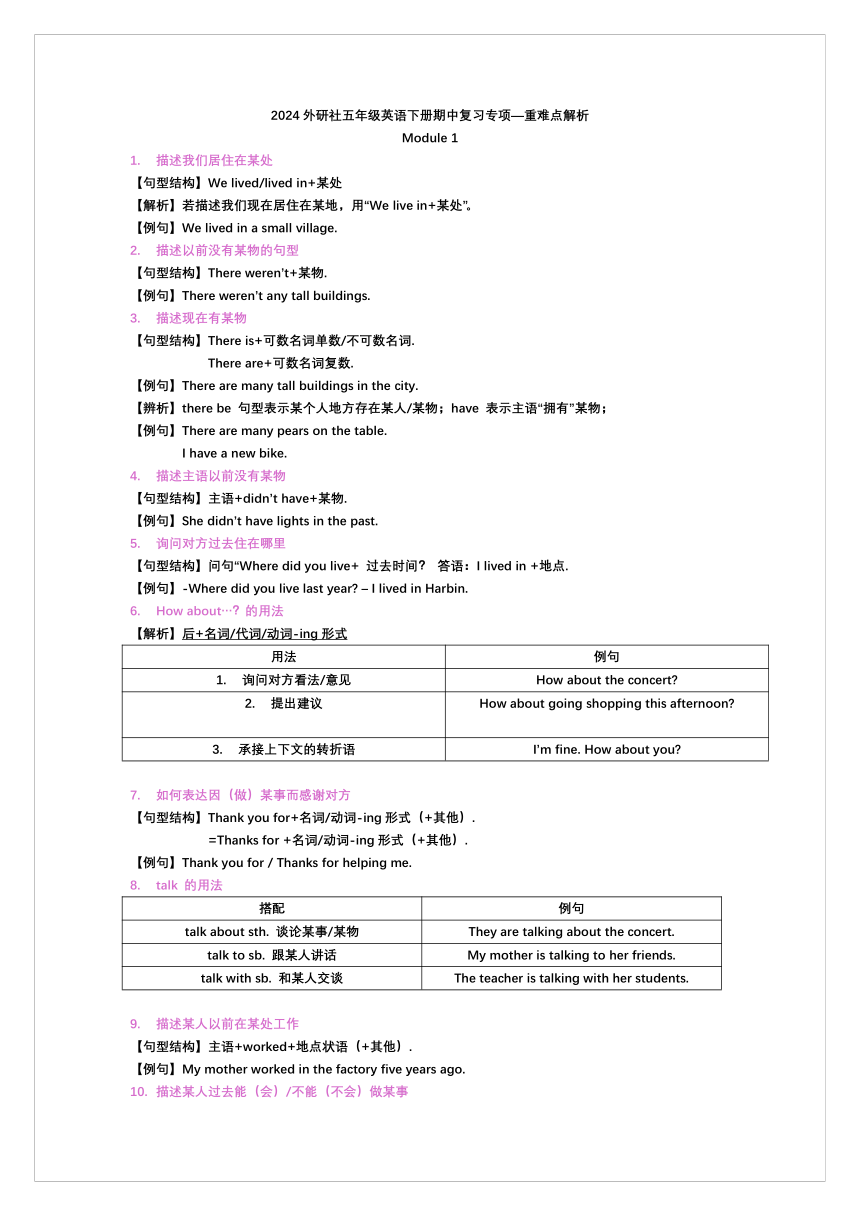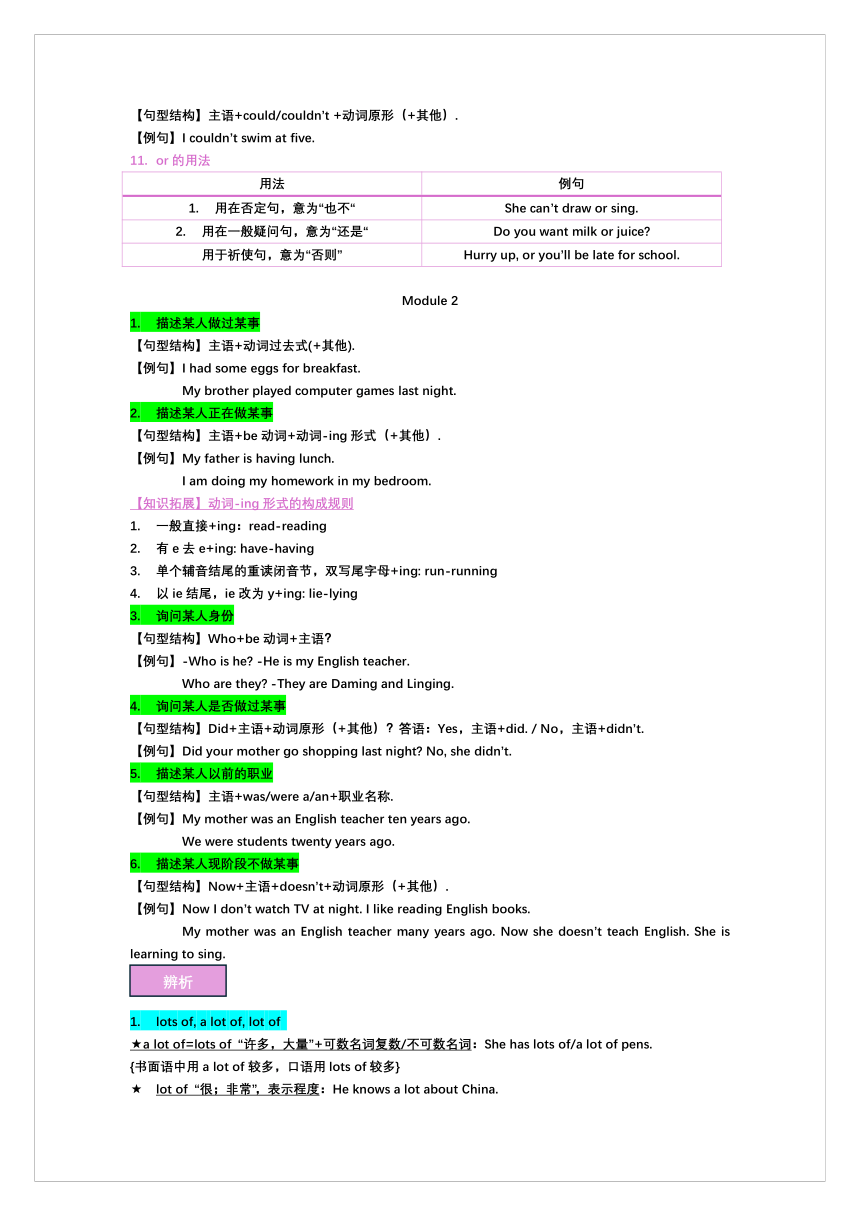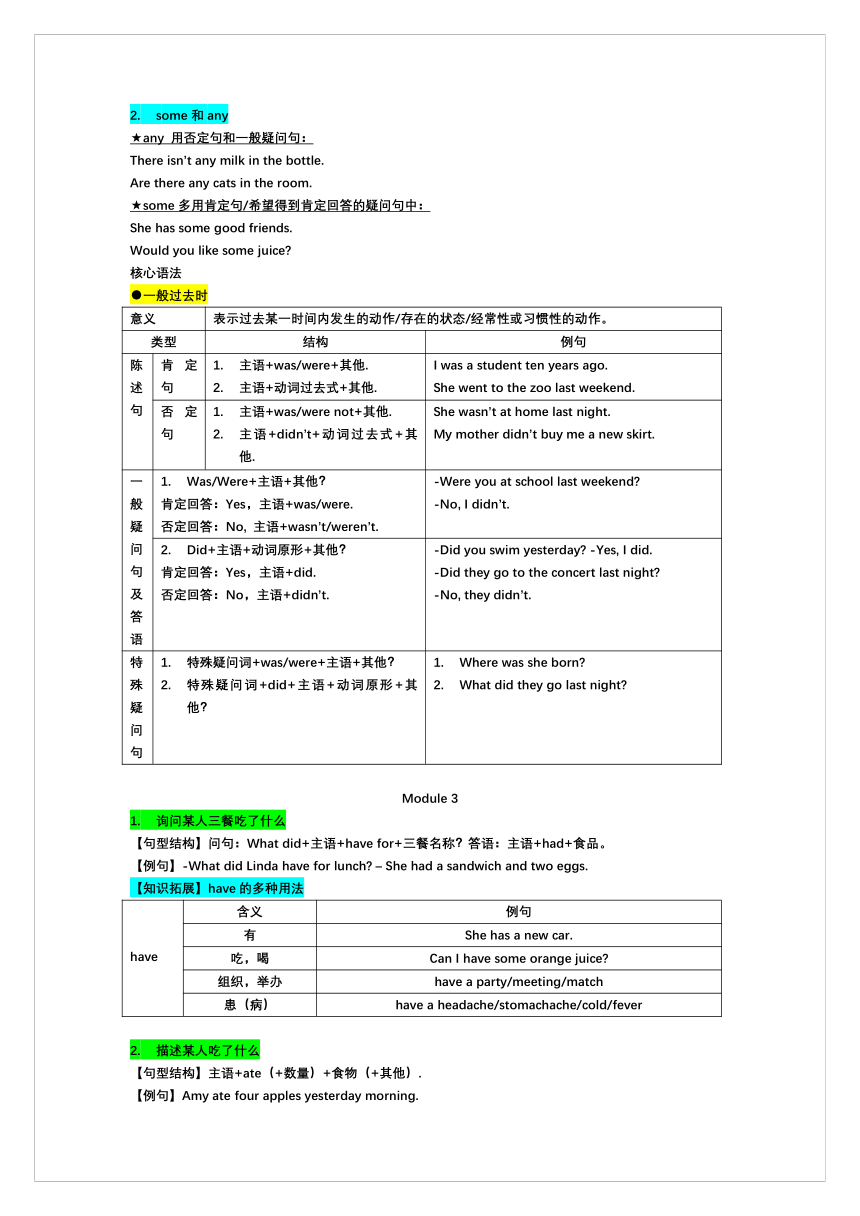期中复习专项-重难点解析(讲义)-2023-2024学年外研版(三起)英语五年级下册
文档属性
| 名称 | 期中复习专项-重难点解析(讲义)-2023-2024学年外研版(三起)英语五年级下册 |  | |
| 格式 | docx | ||
| 文件大小 | 47.9KB | ||
| 资源类型 | 教案 | ||
| 版本资源 | 外研版(三年级起点) | ||
| 科目 | 英语 | ||
| 更新时间 | 2024-04-18 11:35:52 | ||
图片预览



文档简介
2024外研社五年级英语下册期中复习专项—重难点解析
Module 1
描述我们居住在某处
【句型结构】We lived/lived in+某处
【解析】若描述我们现在居住在某地,用“We live in+某处”。
【例句】We lived in a small village.
描述以前没有某物的句型
【句型结构】There weren’t+某物.
【例句】There weren’t any tall buildings.
描述现在有某物
【句型结构】There is+可数名词单数/不可数名词.
There are+可数名词复数.
【例句】There are many tall buildings in the city.
【辨析】there be 句型表示某个人地方存在某人/某物;have 表示主语“拥有”某物;
【例句】There are many pears on the table.
I have a new bike.
描述主语以前没有某物
【句型结构】主语+didn’t have+某物.
【例句】She didn’t have lights in the past.
询问对方过去住在哪里
【句型结构】问句“Where did you live+ 过去时间? 答语:I lived in +地点.
【例句】-Where did you live last year – I lived in Harbin.
How about…?的用法
【解析】后+名词/代词/动词-ing形式
用法 例句
询问对方看法/意见 How about the concert
提出建议 How about going shopping this afternoon
承接上下文的转折语 I’m fine. How about you
如何表达因(做)某事而感谢对方
【句型结构】Thank you for+名词/动词-ing形式(+其他).
=Thanks for +名词/动词-ing形式(+其他).
【例句】Thank you for / Thanks for helping me.
talk 的用法
搭配 例句
talk about sth. 谈论某事/某物 They are talking about the concert.
talk to sb. 跟某人讲话 My mother is talking to her friends.
talk with sb. 和某人交谈 The teacher is talking with her students.
描述某人以前在某处工作
【句型结构】主语+worked+地点状语(+其他).
【例句】My mother worked in the factory five years ago.
描述某人过去能(会)/不能(不会)做某事
【句型结构】主语+could/couldn’t +动词原形(+其他).
【例句】I couldn’t swim at five.
or的用法
用法 例句
用在否定句,意为“也不“ She can’t draw or sing.
用在一般疑问句,意为“还是“ Do you want milk or juice
用于祈使句,意为“否则” Hurry up, or you’ll be late for school.
Module 2
描述某人做过某事
【句型结构】主语+动词过去式(+其他).
【例句】I had some eggs for breakfast.
My brother played computer games last night.
描述某人正在做某事
【句型结构】主语+be动词+动词-ing形式(+其他).
【例句】My father is having lunch.
I am doing my homework in my bedroom.
【知识拓展】动词-ing形式的构成规则
一般直接+ing:read-reading
有e去e+ing: have-having
单个辅音结尾的重读闭音节,双写尾字母+ing: run-running
以ie结尾,ie改为y+ing: lie-lying
询问某人身份
【句型结构】Who+be动词+主语?
【例句】-Who is he -He is my English teacher.
Who are they -They are Daming and Linging.
询问某人是否做过某事
【句型结构】Did+主语+动词原形(+其他)?答语:Yes,主语+did. / No,主语+didn’t.
【例句】Did your mother go shopping last night No, she didn’t.
描述某人以前的职业
【句型结构】主语+was/were a/an+职业名称.
【例句】My mother was an English teacher ten years ago.
We were students twenty years ago.
描述某人现阶段不做某事
【句型结构】Now+主语+doesn’t+动词原形(+其他).
【例句】Now I don’t watch TV at night. I like reading English books.
My mother was an English teacher many years ago. Now she doesn’t teach English. She is learning to sing.
lots of, a lot of, lot of
★a lot of=lots of “许多,大量”+可数名词复数/不可数名词:She has lots of/a lot of pens.
{书面语中用a lot of较多,口语用lots of较多}
lot of “很;非常”,表示程度:He knows a lot about China.
some和any
★any 用否定句和一般疑问句:
There isn’t any milk in the bottle.
Are there any cats in the room.
★some多用肯定句/希望得到肯定回答的疑问句中:
She has some good friends.
Would you like some juice
核心语法
●一般过去时
意义 表示过去某一时间内发生的动作/存在的状态/经常性或习惯性的动作。
类型 结构 例句
陈述句 肯定句 主语+was/were+其他. 主语+动词过去式+其他. I was a student ten years ago. She went to the zoo last weekend.
否定句 主语+was/were not+其他. 主语+didn’t+动词过去式+其他. She wasn’t at home last night. My mother didn’t buy me a new skirt.
一般疑问句及答语 Was/Were+主语+其他? 肯定回答:Yes,主语+was/were. 否定回答:No, 主语+wasn’t/weren’t. -Were you at school last weekend -No, I didn’t.
Did+主语+动词原形+其他? 肯定回答:Yes,主语+did. 否定回答:No,主语+didn’t. -Did you swim yesterday -Yes, I did. -Did they go to the concert last night -No, they didn’t.
特殊疑问句 特殊疑问词+was/were+主语+其他? 特殊疑问词+did+主语+动词原形+其他? Where was she born What did they go last night
Module 3
询问某人三餐吃了什么
【句型结构】问句:What did+主语+have for+三餐名称?答语:主语+had+食品。
【例句】-What did Linda have for lunch – She had a sandwich and two eggs.
【知识拓展】have的多种用法
have 含义 例句
有 She has a new car.
吃,喝 Can I have some orange juice
组织,举办 have a party/meeting/match
患(病) have a headache/stomachache/cold/fever
描述某人吃了什么
【句型结构】主语+ate(+数量)+食物(+其他).
【例句】Amy ate four apples yesterday morning.
描述某人非常喜欢某物
【句型结构】主语+like/likes+某物+very much.
【例句】My mother likes fish very much.
询问某人是否喜欢某物
【句型结构】问句:Do/Does+主语+like+某物?
答语:Yes,主语+do/does. / No,主语+don’t/doesn’t.
【例句】-Does your mum like fish -No, she doesn’t.
描述食物味道
【句型结构】食物名称+be动词(is/are)+描述食物味道的形容词.
【例句】The cake is sweet.
【知识拓展】描述食物特征的常见词汇
类型 例子
外形 big/small/long
颜色 red/green/blue/yellow
味道 sour(酸的/sweet/hot(辣的)/salty(咸的)/bitter(苦的)
形态 soft(软的)/hard(硬的)/crisp(酥脆的)
口感 yummy(很好吃的)/tasty(可口的)/delicious/juicy(多汁的)
描述某人将要/打算做某事
【句型结构】主语+be动词+going to+动词原形(+其他).
【例句】She is going to visit Harbin next month.
核心语法
●动词过去式的变化规则
变化规则 动词原形 过去式
一般直接+ed walk walked
不发音e结尾+d hope hoped
辅音+y结尾,y改i+ed study studied
一个辅音结尾重读闭音节,双写尾字母+ed stop stopped
★常见的不规则动词过去式 1. AA型:read—read put—put cut—cut 2. AB型:have-had learn-learned/learnt teach-taught buy-bought drink-drank sing-sang swim-swam give-gave know-knew write-wrote draw-drew go-went eat-ate tell-told
Module 4
表达某人有某物
【句型结构】主语+have/has got+名词(短语)(+其他).
【例句】She has got a book about music.
【辨析】(1)have意为“举办/吃/喝/进行(活动)等,have got 不能替代;(2)与情态动词can/may等连用,用have;(3)过去式用have 过去式had;
以Let’s开头的祈使句
【句型结构】Let’s+动词原形(+其他). 回答:OK. / Good idea. /All right. / Sorry, I …
【例句】-Let us play basketball. – Good idea.
介绍某类物品
【句型结构】These are+物品(复数)+about+表示类别的名词.
【例句】These are books about English.
询问某类物品在哪里
【句型结构】问:Where are the+物品(复数)+ about+表示类别的名词?
答:They are+表示地点的介词短语.
【例句】-Where are the books about music
- They are on Shelf B.
want的用法:意为“想要“,有人称/时态/数的变化。
搭配 含义 例句
want+某物 想要某物 She wants a bike.
want to do sth. 想要做某事 I want to buy a dog.
want+某人+to do sth. 想要某人做某事 I want my mum to buy a new bike for me.
询问自己在哪里可以找到某物
【句型结构】Where can I find+某物?
【例句】-Where can I find my English book -It’s on your desk.
描述能从某处找到信息
【句型结构】主语+can find information from+名词.
【例句】-Where can I find information about the sun
-You can find information form the science book.
8. 表示“也“的词
词语 用法 例句
too 肯定句/疑问句,句尾逗号隔开 He likes chocolate and I like chocolate, too.
also be动词/助动词/情态动词之后,实义动词前 He is a teacher. I am also a teacher.
either 句末,否定句 He doesn’t like apples and I don’t like apples either.
as well 肯定句句末,不加逗号 He wants some cookies. I want some cookies as well.
★指示代词
指示代词 用法
this 指距离说话人近的人/物
these 指距离说话人近的多个人/物
that 指距离说话人远的人/物
those 指距离说话人远的多个人/物
Module 5
描述事物特征句型(1)
【句型结构】This/That/The+单个物品+is+表示特征形容词
e.g. This purple schoolbag is beautiful.
描述事物特征句型(2)
【句型结构】It/单个物品+has got+表示特征的名词(短语)
★It has got=It’s got
e.g. A car has got four wheels.
【注意】表示某人拥有某物,句型为“人+have/has got+物品.”
e.g. He has got a new pen.
描述事物特征句型(3)
【句型结构】It’s+表示特征的形容词
★and连接两个并列的形容词
e.g. My mum bought me a new schoolbag yesterday. It’s nice and beautiful.
表达“它对……来说太……”
【句型结构】It’s too + adj. + for+某人.
★too此处意为“太”
e.g. The tree is too tall for me to climb.
拓展知识点
one的用法
教材原句:I’ll buy you a new one.
【归纳】one 指代前面提到的同类事物中的一个,避免重复。
【拓展】it 指代前面提到的同一事物。
e.g. The purple pens are nice. Give me one, please.
take 的用法
教材原句:We’ll take it.
【归纳】take的用法
Module 1
描述我们居住在某处
【句型结构】We lived/lived in+某处
【解析】若描述我们现在居住在某地,用“We live in+某处”。
【例句】We lived in a small village.
描述以前没有某物的句型
【句型结构】There weren’t+某物.
【例句】There weren’t any tall buildings.
描述现在有某物
【句型结构】There is+可数名词单数/不可数名词.
There are+可数名词复数.
【例句】There are many tall buildings in the city.
【辨析】there be 句型表示某个人地方存在某人/某物;have 表示主语“拥有”某物;
【例句】There are many pears on the table.
I have a new bike.
描述主语以前没有某物
【句型结构】主语+didn’t have+某物.
【例句】She didn’t have lights in the past.
询问对方过去住在哪里
【句型结构】问句“Where did you live+ 过去时间? 答语:I lived in +地点.
【例句】-Where did you live last year – I lived in Harbin.
How about…?的用法
【解析】后+名词/代词/动词-ing形式
用法 例句
询问对方看法/意见 How about the concert
提出建议 How about going shopping this afternoon
承接上下文的转折语 I’m fine. How about you
如何表达因(做)某事而感谢对方
【句型结构】Thank you for+名词/动词-ing形式(+其他).
=Thanks for +名词/动词-ing形式(+其他).
【例句】Thank you for / Thanks for helping me.
talk 的用法
搭配 例句
talk about sth. 谈论某事/某物 They are talking about the concert.
talk to sb. 跟某人讲话 My mother is talking to her friends.
talk with sb. 和某人交谈 The teacher is talking with her students.
描述某人以前在某处工作
【句型结构】主语+worked+地点状语(+其他).
【例句】My mother worked in the factory five years ago.
描述某人过去能(会)/不能(不会)做某事
【句型结构】主语+could/couldn’t +动词原形(+其他).
【例句】I couldn’t swim at five.
or的用法
用法 例句
用在否定句,意为“也不“ She can’t draw or sing.
用在一般疑问句,意为“还是“ Do you want milk or juice
用于祈使句,意为“否则” Hurry up, or you’ll be late for school.
Module 2
描述某人做过某事
【句型结构】主语+动词过去式(+其他).
【例句】I had some eggs for breakfast.
My brother played computer games last night.
描述某人正在做某事
【句型结构】主语+be动词+动词-ing形式(+其他).
【例句】My father is having lunch.
I am doing my homework in my bedroom.
【知识拓展】动词-ing形式的构成规则
一般直接+ing:read-reading
有e去e+ing: have-having
单个辅音结尾的重读闭音节,双写尾字母+ing: run-running
以ie结尾,ie改为y+ing: lie-lying
询问某人身份
【句型结构】Who+be动词+主语?
【例句】-Who is he -He is my English teacher.
Who are they -They are Daming and Linging.
询问某人是否做过某事
【句型结构】Did+主语+动词原形(+其他)?答语:Yes,主语+did. / No,主语+didn’t.
【例句】Did your mother go shopping last night No, she didn’t.
描述某人以前的职业
【句型结构】主语+was/were a/an+职业名称.
【例句】My mother was an English teacher ten years ago.
We were students twenty years ago.
描述某人现阶段不做某事
【句型结构】Now+主语+doesn’t+动词原形(+其他).
【例句】Now I don’t watch TV at night. I like reading English books.
My mother was an English teacher many years ago. Now she doesn’t teach English. She is learning to sing.
lots of, a lot of, lot of
★a lot of=lots of “许多,大量”+可数名词复数/不可数名词:She has lots of/a lot of pens.
{书面语中用a lot of较多,口语用lots of较多}
lot of “很;非常”,表示程度:He knows a lot about China.
some和any
★any 用否定句和一般疑问句:
There isn’t any milk in the bottle.
Are there any cats in the room.
★some多用肯定句/希望得到肯定回答的疑问句中:
She has some good friends.
Would you like some juice
核心语法
●一般过去时
意义 表示过去某一时间内发生的动作/存在的状态/经常性或习惯性的动作。
类型 结构 例句
陈述句 肯定句 主语+was/were+其他. 主语+动词过去式+其他. I was a student ten years ago. She went to the zoo last weekend.
否定句 主语+was/were not+其他. 主语+didn’t+动词过去式+其他. She wasn’t at home last night. My mother didn’t buy me a new skirt.
一般疑问句及答语 Was/Were+主语+其他? 肯定回答:Yes,主语+was/were. 否定回答:No, 主语+wasn’t/weren’t. -Were you at school last weekend -No, I didn’t.
Did+主语+动词原形+其他? 肯定回答:Yes,主语+did. 否定回答:No,主语+didn’t. -Did you swim yesterday -Yes, I did. -Did they go to the concert last night -No, they didn’t.
特殊疑问句 特殊疑问词+was/were+主语+其他? 特殊疑问词+did+主语+动词原形+其他? Where was she born What did they go last night
Module 3
询问某人三餐吃了什么
【句型结构】问句:What did+主语+have for+三餐名称?答语:主语+had+食品。
【例句】-What did Linda have for lunch – She had a sandwich and two eggs.
【知识拓展】have的多种用法
have 含义 例句
有 She has a new car.
吃,喝 Can I have some orange juice
组织,举办 have a party/meeting/match
患(病) have a headache/stomachache/cold/fever
描述某人吃了什么
【句型结构】主语+ate(+数量)+食物(+其他).
【例句】Amy ate four apples yesterday morning.
描述某人非常喜欢某物
【句型结构】主语+like/likes+某物+very much.
【例句】My mother likes fish very much.
询问某人是否喜欢某物
【句型结构】问句:Do/Does+主语+like+某物?
答语:Yes,主语+do/does. / No,主语+don’t/doesn’t.
【例句】-Does your mum like fish -No, she doesn’t.
描述食物味道
【句型结构】食物名称+be动词(is/are)+描述食物味道的形容词.
【例句】The cake is sweet.
【知识拓展】描述食物特征的常见词汇
类型 例子
外形 big/small/long
颜色 red/green/blue/yellow
味道 sour(酸的/sweet/hot(辣的)/salty(咸的)/bitter(苦的)
形态 soft(软的)/hard(硬的)/crisp(酥脆的)
口感 yummy(很好吃的)/tasty(可口的)/delicious/juicy(多汁的)
描述某人将要/打算做某事
【句型结构】主语+be动词+going to+动词原形(+其他).
【例句】She is going to visit Harbin next month.
核心语法
●动词过去式的变化规则
变化规则 动词原形 过去式
一般直接+ed walk walked
不发音e结尾+d hope hoped
辅音+y结尾,y改i+ed study studied
一个辅音结尾重读闭音节,双写尾字母+ed stop stopped
★常见的不规则动词过去式 1. AA型:read—read put—put cut—cut 2. AB型:have-had learn-learned/learnt teach-taught buy-bought drink-drank sing-sang swim-swam give-gave know-knew write-wrote draw-drew go-went eat-ate tell-told
Module 4
表达某人有某物
【句型结构】主语+have/has got+名词(短语)(+其他).
【例句】She has got a book about music.
【辨析】(1)have意为“举办/吃/喝/进行(活动)等,have got 不能替代;(2)与情态动词can/may等连用,用have;(3)过去式用have 过去式had;
以Let’s开头的祈使句
【句型结构】Let’s+动词原形(+其他). 回答:OK. / Good idea. /All right. / Sorry, I …
【例句】-Let us play basketball. – Good idea.
介绍某类物品
【句型结构】These are+物品(复数)+about+表示类别的名词.
【例句】These are books about English.
询问某类物品在哪里
【句型结构】问:Where are the+物品(复数)+ about+表示类别的名词?
答:They are+表示地点的介词短语.
【例句】-Where are the books about music
- They are on Shelf B.
want的用法:意为“想要“,有人称/时态/数的变化。
搭配 含义 例句
want+某物 想要某物 She wants a bike.
want to do sth. 想要做某事 I want to buy a dog.
want+某人+to do sth. 想要某人做某事 I want my mum to buy a new bike for me.
询问自己在哪里可以找到某物
【句型结构】Where can I find+某物?
【例句】-Where can I find my English book -It’s on your desk.
描述能从某处找到信息
【句型结构】主语+can find information from+名词.
【例句】-Where can I find information about the sun
-You can find information form the science book.
8. 表示“也“的词
词语 用法 例句
too 肯定句/疑问句,句尾逗号隔开 He likes chocolate and I like chocolate, too.
also be动词/助动词/情态动词之后,实义动词前 He is a teacher. I am also a teacher.
either 句末,否定句 He doesn’t like apples and I don’t like apples either.
as well 肯定句句末,不加逗号 He wants some cookies. I want some cookies as well.
★指示代词
指示代词 用法
this 指距离说话人近的人/物
these 指距离说话人近的多个人/物
that 指距离说话人远的人/物
those 指距离说话人远的多个人/物
Module 5
描述事物特征句型(1)
【句型结构】This/That/The+单个物品+is+表示特征形容词
e.g. This purple schoolbag is beautiful.
描述事物特征句型(2)
【句型结构】It/单个物品+has got+表示特征的名词(短语)
★It has got=It’s got
e.g. A car has got four wheels.
【注意】表示某人拥有某物,句型为“人+have/has got+物品.”
e.g. He has got a new pen.
描述事物特征句型(3)
【句型结构】It’s+表示特征的形容词
★and连接两个并列的形容词
e.g. My mum bought me a new schoolbag yesterday. It’s nice and beautiful.
表达“它对……来说太……”
【句型结构】It’s too + adj. + for+某人.
★too此处意为“太”
e.g. The tree is too tall for me to climb.
拓展知识点
one的用法
教材原句:I’ll buy you a new one.
【归纳】one 指代前面提到的同类事物中的一个,避免重复。
【拓展】it 指代前面提到的同一事物。
e.g. The purple pens are nice. Give me one, please.
take 的用法
教材原句:We’ll take it.
【归纳】take的用法
同课章节目录
